A Game Theoretic Optimization Method for Energy Efficient Global Connectivity in Hybrid Wireless Sensor Networks
Abstract
:1. Introduction
- For efficient resource management in hybrid WSNs, we present an optimization method based on game theory. By using the proposed model, cluster heads connecting cellular networks can find the optimal base station under the given cost function.
- We formulate different characteristics of cellular networks into a cost function for game theoretic models. To apply the divergent advances in cellular networks, e.g., femtocells, LTE-M, Sigfox, etc., we set a parameter that represents power price per a communication unit, such as a slot or a packet. Depending on wireless multiplexing technologies, base stations have constraints in available slots or SNIR (signal to noise plus interference ratio). Thus, we provide a cost function for TDMA/FDMA and CDMA, respectively.
- We perform simulation and analysis on the proposed model with respect to efficiency, flexibility and resilience against changes (mobility). From the result, we can find interesting facts, such as the optimal coordination is important for lowering power price, i.e., using low power wireless technologies.
2. System Model and Motivations
2.1. Two-Tier Hybrid WSN
2.2. Background
2.3. Cellular Model for Cluster Heads
2.4. Optimization Problems for Cluster Heads
3. Optimal Base Station Selection of Hybrid Cluster Heads
3.1. Optimization Process Overview
- Cluster heads identify reachable (within communication range) base stations, (of cluster head i), and report the information to a sink node with their location .
- The sink node gathers information from cluster heads and applies the proposed game theory model with the pre-knowledge on the base stations.
- For each cluster head, the sink node calculates a feasibility vector and reports it.
- A cluster head selects a base station based on its strategy with the feasibility vector.
- Repeat the whole process at every time interval .
3.2. Game Theoretic Models for TDMA and FDMA Systems
- Set the initial value for .
- Store as .
- For all , solve Equation (5) by assuming that the cluster heads in the set keep their solutions fixed.
- Repeat Steps 2 and 3 until .
3.3. Game Theory Formulation for CDMA System
3.4. Base Station Selection Strategies
| Algorithm 1: Process of the i-th cluster head. |
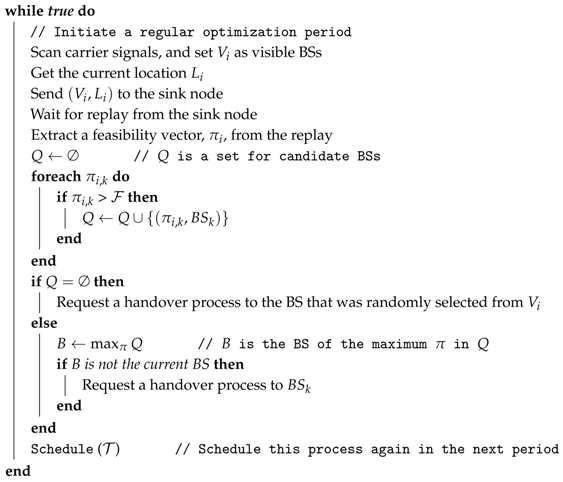 |
| Algorithm 2: Process of the sink node. |
 |
4. Evaluations
4.1. Simulation Setup
4.2. TDMA Base Station
4.3. CDMA Base Station
5. Related Work
6. Conclusions
Acknowledgments
Author Contributions
Conflicts of Interest
References
- Jain, K.; Padhye, J.; Padmanabhan, V.N.; Qiu, L. Impact of interference on multi-hop wireless network performance. Wirel. Netw. 2005, 11, 471–487. [Google Scholar] [CrossRef]
- Fudenberg, D.; Tirole, J. Game Theory; MIT Press: Cambridge, MA, USA, 1991; p. 86. [Google Scholar]
- Shan, X.; Zhuang, J. Hybrid defensive resource allocations in the face of partially strategic attackers in a sequential defender—Attacker game. Eur. J. Oper. Res. 2013, 228, 262–272. [Google Scholar] [CrossRef]
- Nikoofal, M.E.; Zhuang, J. Robust allocation of a defensive budget considering an attacker’s private information. Risk Anal. 2012, 32, 930–943. [Google Scholar] [CrossRef] [PubMed]
- Johari, R.; Tsitsiklis, J.N. Efficiency loss in a network resource allocation game. Math. Oper. Res. 2004, 29, 407–435. [Google Scholar] [CrossRef]
- Redl, S.; Oliphant, M.W.; Weber, M.K.; Weber, M.K. An Introduction to GSM; Artech House Inc.: Norwood, MA, USA, 1995. [Google Scholar]
- Mouly, M.; Pautet, M.B. The GSM System for Mobile Communications; Telecom Publishing: Brighton, UK, 1992. [Google Scholar]
- Ojanpera, T.; Prasad, R. Wideband CDMA For Third Generation Mobile Communications: Universal Personal Communications; Artech House Inc.: Norwood, MA, USA, 1998. [Google Scholar]
- Rappaport, T.S. Wireless Communications: Principles and Practice; Prentice Hall PTR: Upper Saddle River, NJ, USA, 1996; Volume 2. [Google Scholar]
- Chung, K.S.; Ely, J.C. Implementation with Near-Complete Information. Econometrica 2003, 71, 857–871. [Google Scholar] [CrossRef]
- Kleinrock, L. Queueing Systems. Volume I: Theory; Wiley-Interscience: New York, NY, USA, 1975. [Google Scholar]
- Vives, X. Nash equilibrium with strategic complementarities. J. Math. Econ. 1990, 19, 305–321. [Google Scholar] [CrossRef]
- Milgrom, P.; Roberts, J. Rationalizability, learning, and equilibrium in games with strategic complementarities. Econometrica 1990, 58, 1255–1277. [Google Scholar] [CrossRef]
- Wong, T.W.; Prabhu, V.K. Optimum sectorization for CDMA 1900 base stations. In Proceedings of the IEEE 47th Vehicular Technology Conference, Phoenix, AZ, USA, 4–7 May 1997; Volume 2, pp. 1177–1181.
- Jiang, H.; Jordan, S. A pricing model for high speed networks with guaranteed quality of service. In Proceedings of the IEEE Fifteenth Annual Joint Conference of the IEEE Computer Societies, Networking the Next Generation (INFOCOM ’96), San Francisco, CA, USA, 24–28 March 1996; Volume 2, pp. 888–895.
- Kelly, F.P.; Maulloo, A.K.; Tan, D.K. Rate control for communication networks: Shadow prices, proportional fairness and stability. J. Oper. Res. Soc. 1998, 49, 237–252. [Google Scholar] [CrossRef]
- Liu, P.; Zhang, P.; Jordan, S.; Honig, M.L. Single-cell forward link power allocation using pricing in wireless networks. IEEE Trans. Wirel. Commun. 2004, 3, 533–543. [Google Scholar] [CrossRef]
- MacKie-Mason, J.K.; Varian, H.R. Pricing congestible network resources. IEEE J. Sel. Areas Commun. 1995, 13, 1141–1149. [Google Scholar] [CrossRef]
- Saraydar, C.U.; Mandayam, N.B.; Goodman, D.J. Pricing and power control in a multicell wireless data network. IEEE J. Sel. Areas Commun. 2001, 19, 1883–1892. [Google Scholar] [CrossRef]
- Liu, P.; Honig, M.L.; Jordan, S. Forward-link CDMA resource allocation based on pricing. In Proceedings of the Wireless Communications and Networking Confernce (CNC), Chicago, IL, USA, 23–28 September 2000; Volume 3, pp. 1410–1414.
- Zhou, C.; Honig, M.; Jordan, S. Two-cell power allocation for wireless data based on pricing. In Proceedings of the Thirty-Ninth Annual Allerton Conference on Communication Control and Computing, the University of Illinois at Urbana-Champaign, Urbana, IL, USA, 3–5 October 2001; Volume 39, pp. 1088–1097.
- Ji, H.; Huang, C.Y. Non-cooperative uplink power control in cellular radio systems. Wirel. Netw. 1998, 4, 233–240. [Google Scholar] [CrossRef]
- Saraydar, C.U.; Mandayam, N.B.; Goodman, D.J. Efficient power control via pricing in wireless data networks. IEEE Trans. Commun. 2002, 50, 291–303. [Google Scholar] [CrossRef]
- Amzallag, D.; Bar-Yehuda, R.; Raz, D.; Scalosub, G. Cell selection in 4G cellular networks. In Proceedings of the 27th Conference on Computer Communications INFOCOM, Phoenix, AZ, USA, 13–18 April 2008.
- Yaacoub, E.; Imran, A.; Dawy, Z.; Abu-Dayya, A. A game theoretic framework for energy efficient deployment and operation of heterogeneous LTE networks. In Proceedings of the 2013 IEEE 18th International Workshop on Computer Aided Modeling and Design of Communication Links and Networks (CAMAD), Berlin, Germany, 25–27 September 2013; pp. 33–37.
- Mustika, I.W.; Nurcahyo, A.; Yamamoto, K.; Widyawan. A game-theoretic framework for joint base station and resource selection in LTE heterogeneous networks. In Proceedings of the 2013 19th Asia-Pacific Conference on Communications (APCC), Bali, Indonesia, 29–31 August 2013; pp. 447–452.
- Safdar, H.; Fisal, N.; Ullah, R.; Maqbool, W.; Asraf, F.; Khalid, Z.; Khan, A.S. Resource allocation for uplink M2M communication: A game theory approach. In Proceedings of the 2013 IEEE Symposium on Wireless Technology and Applications (ISWTA), Kuching, Malaysia, 22–25 September 2013; pp. 48–52.
- Mankar, P.D.; Das, G.; Pathak, S. A Novel Proportionally Fair Spectrum Allocation in Two Tiered Cellular Networks. IEEE Commun. Lett. 2015, 19, 629–632. [Google Scholar] [CrossRef]
- Huang, J.; Yin, Y.; Sun, Y.; Zhao, Y.; Xing, C.C.; Duan, Q. Game theoretic resource allocation for multicell D2D communications with incomplete information. In Proceedings of the 2015 IEEE International Conference on Communications (ICC), London, UK, 8–12 June 2015; pp. 3039–3044.
- Khoufi, I.; Minet, P.; Koulali, M.A.; Erradi, M. A game theory-based approach for robots deploying wireless sensor nodes. In Proceedings of the 2015 International Wireless Communications and Mobile Computing Conference (IWCMC), Dubrovnik, Croatia, 24–28 August 2015; pp. 557–562.
- Das, T.; Roy, S. Game theory based mobile wireless sensor network for area coverage. In Proceedings of the 2014 International Conference on High Performance Computing and Applications (ICHPCA), Bhubaneswar, India, 22–24 December 2014; pp. 1–6.
- Gao, L.; Wang, X.; Sun, G.; Xu, Y. A game approach for cell selection and resource allocation in heterogeneous wireless networks. In Proceedings of the 8th Annual IEEE Communications Society Conference on Sensor, Mesh and Ad Hoc Communications and Networks (SECON), Salt Lake City, UT, USA, 27–30 June 2011; pp. 530–538.
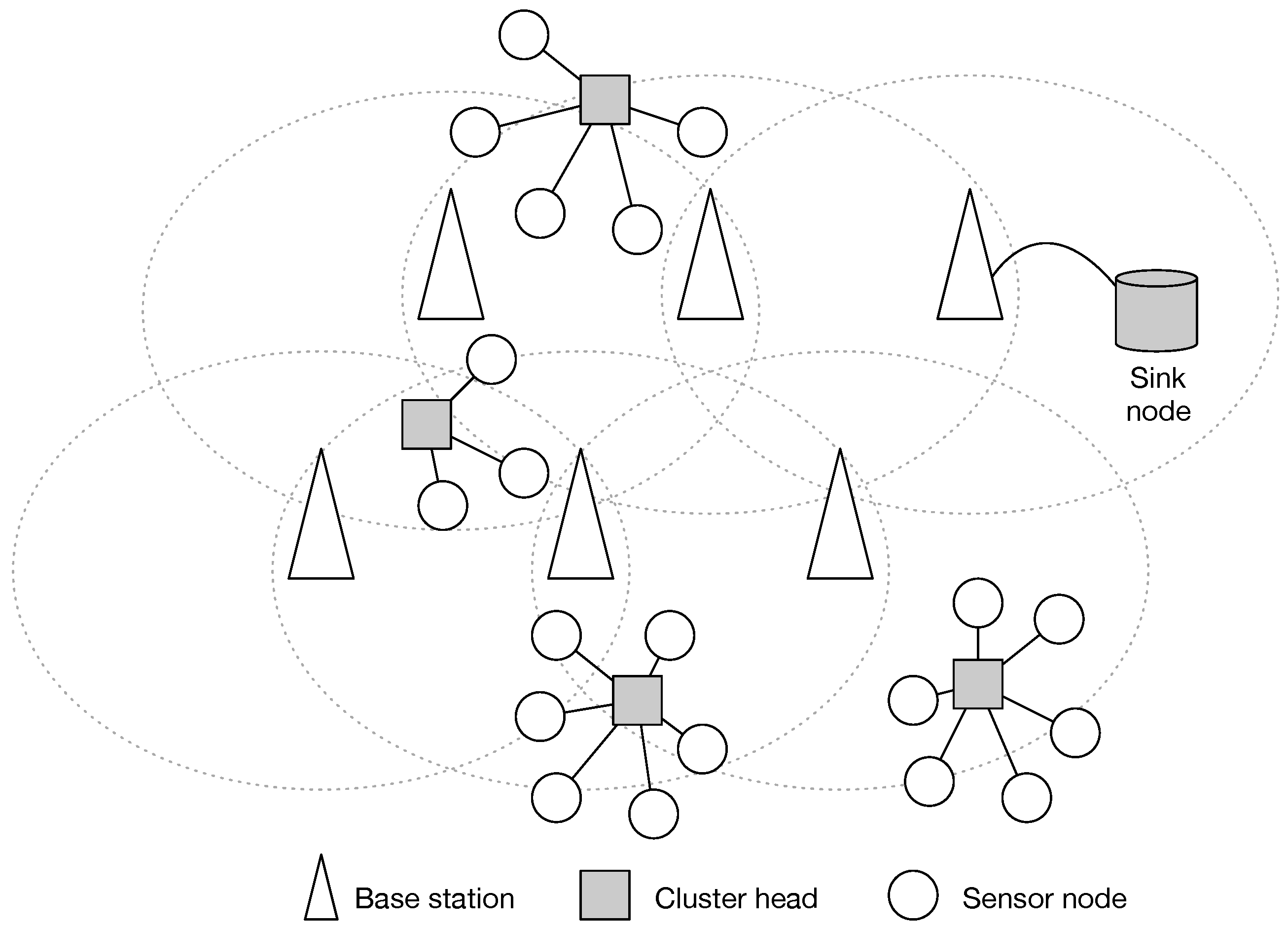
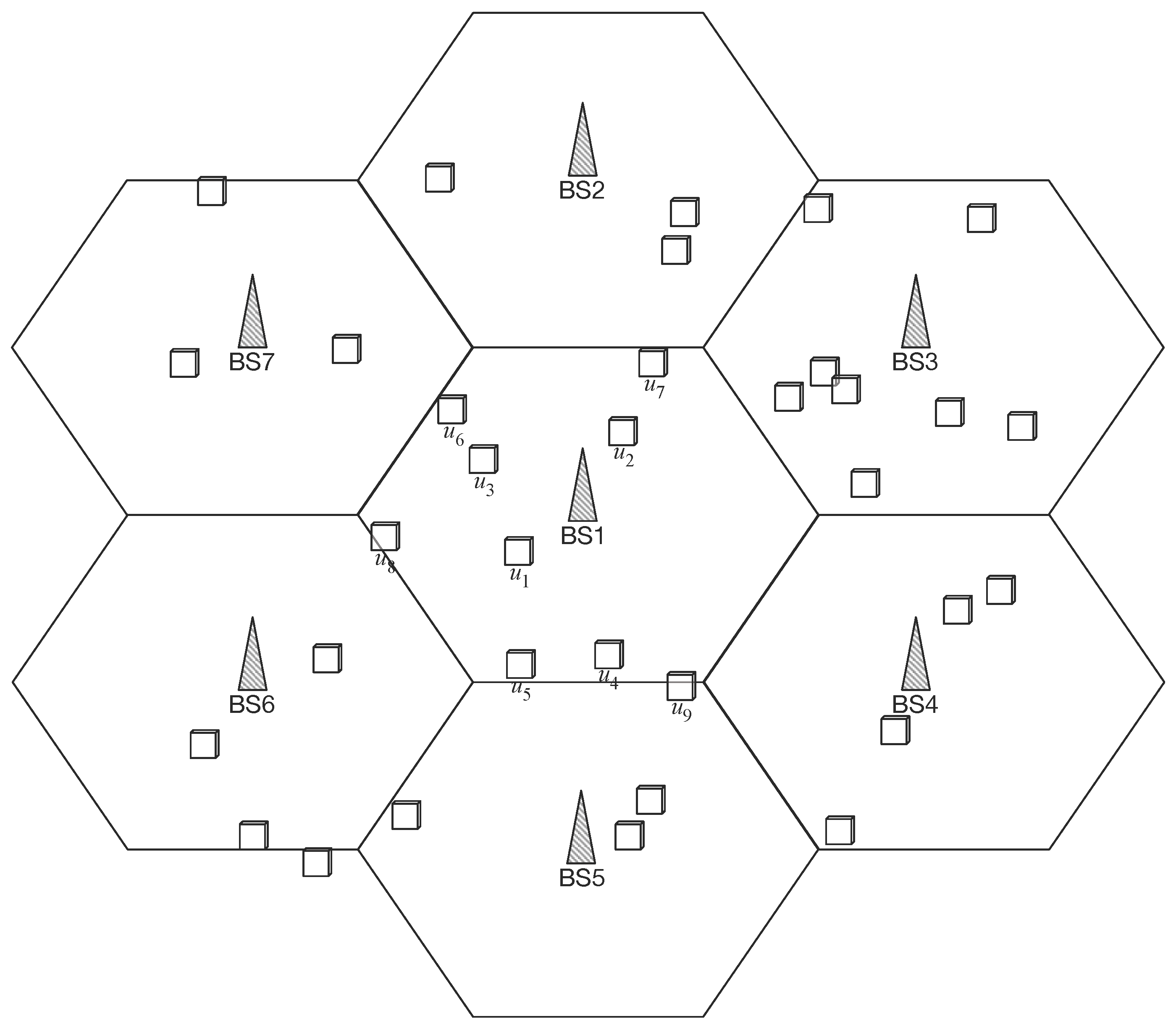
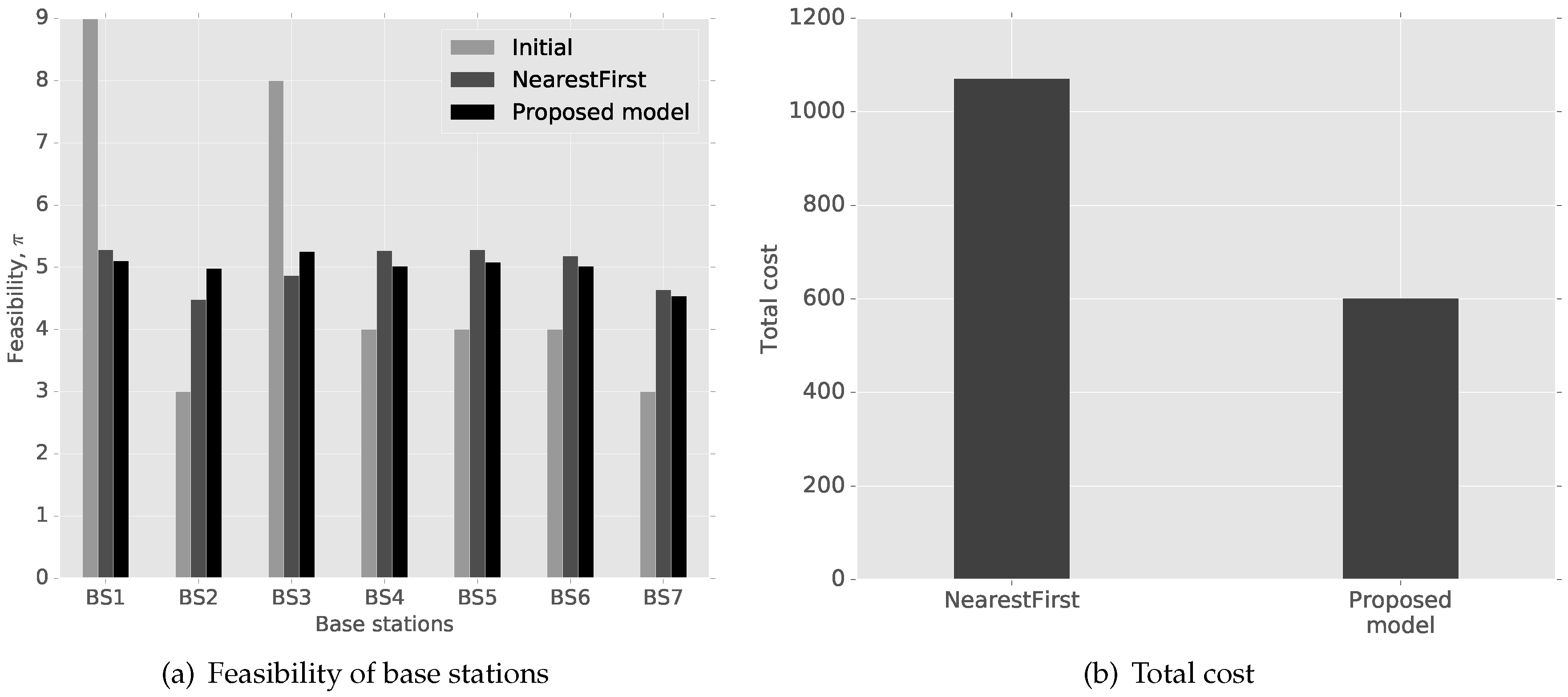
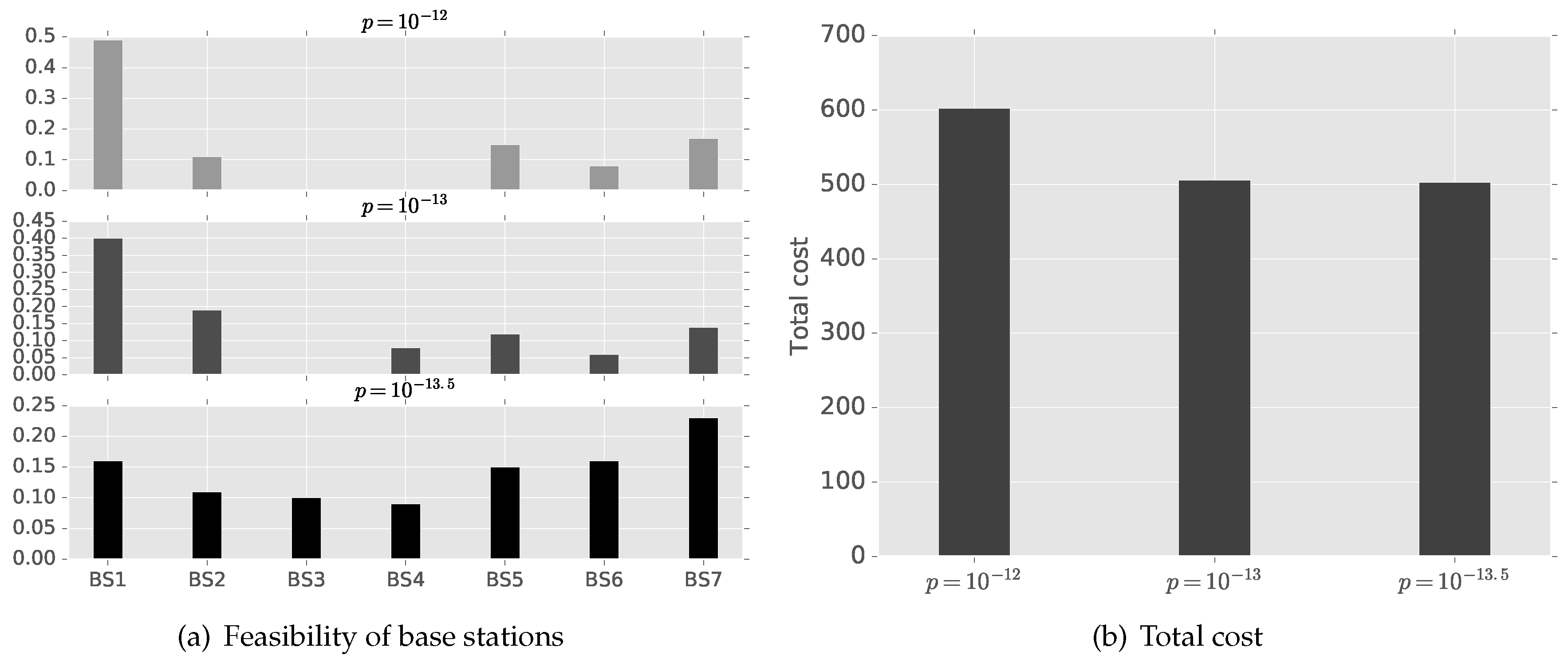
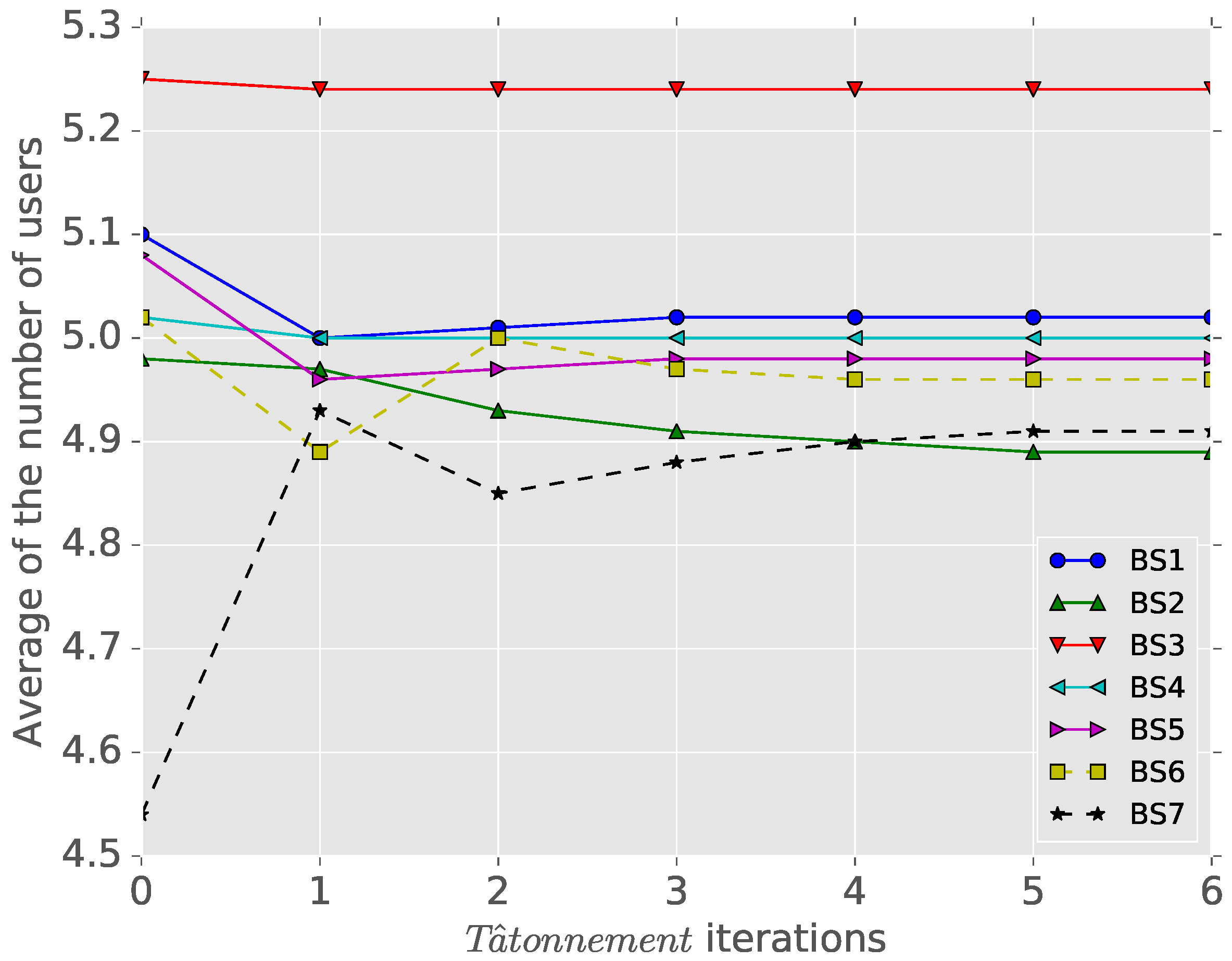
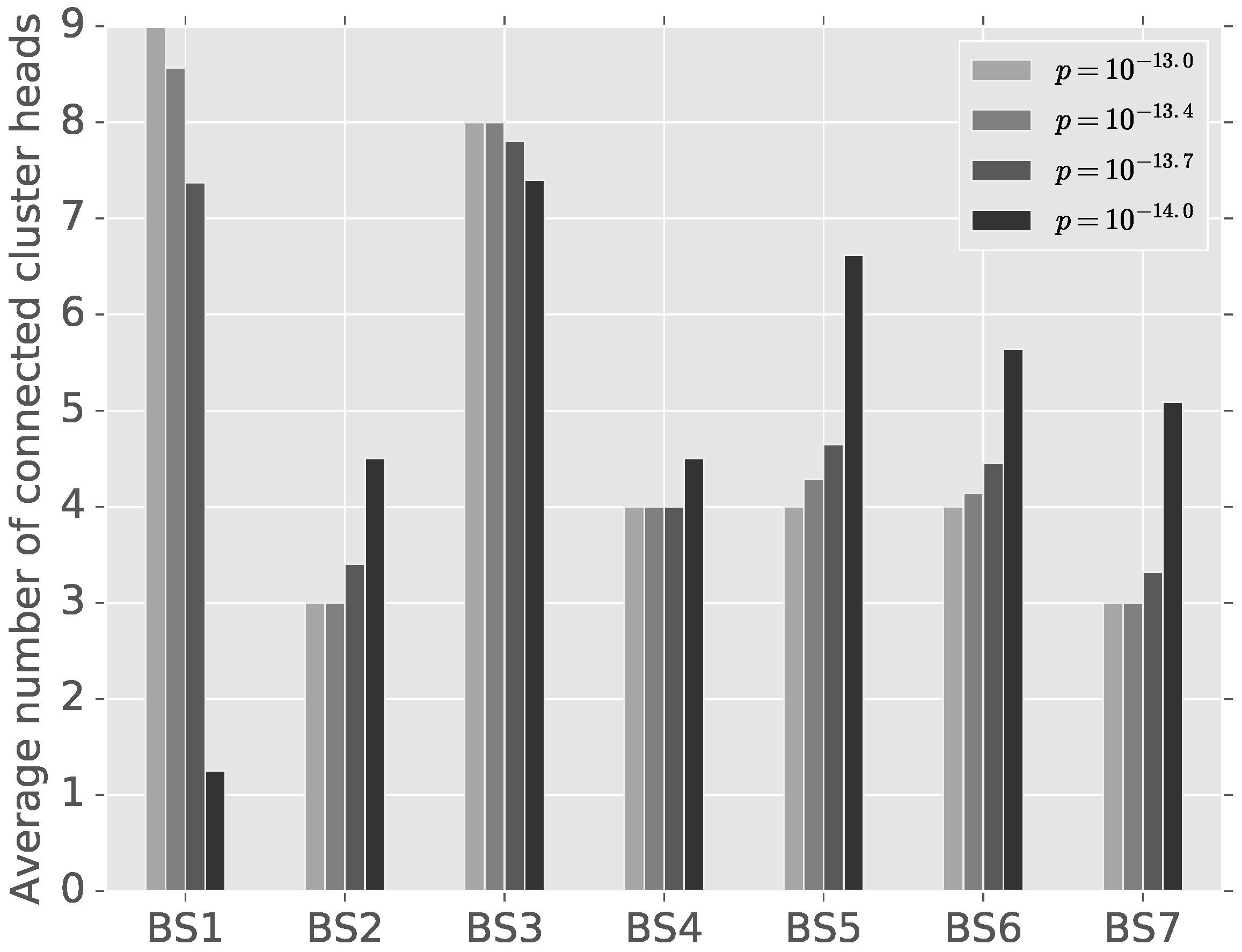
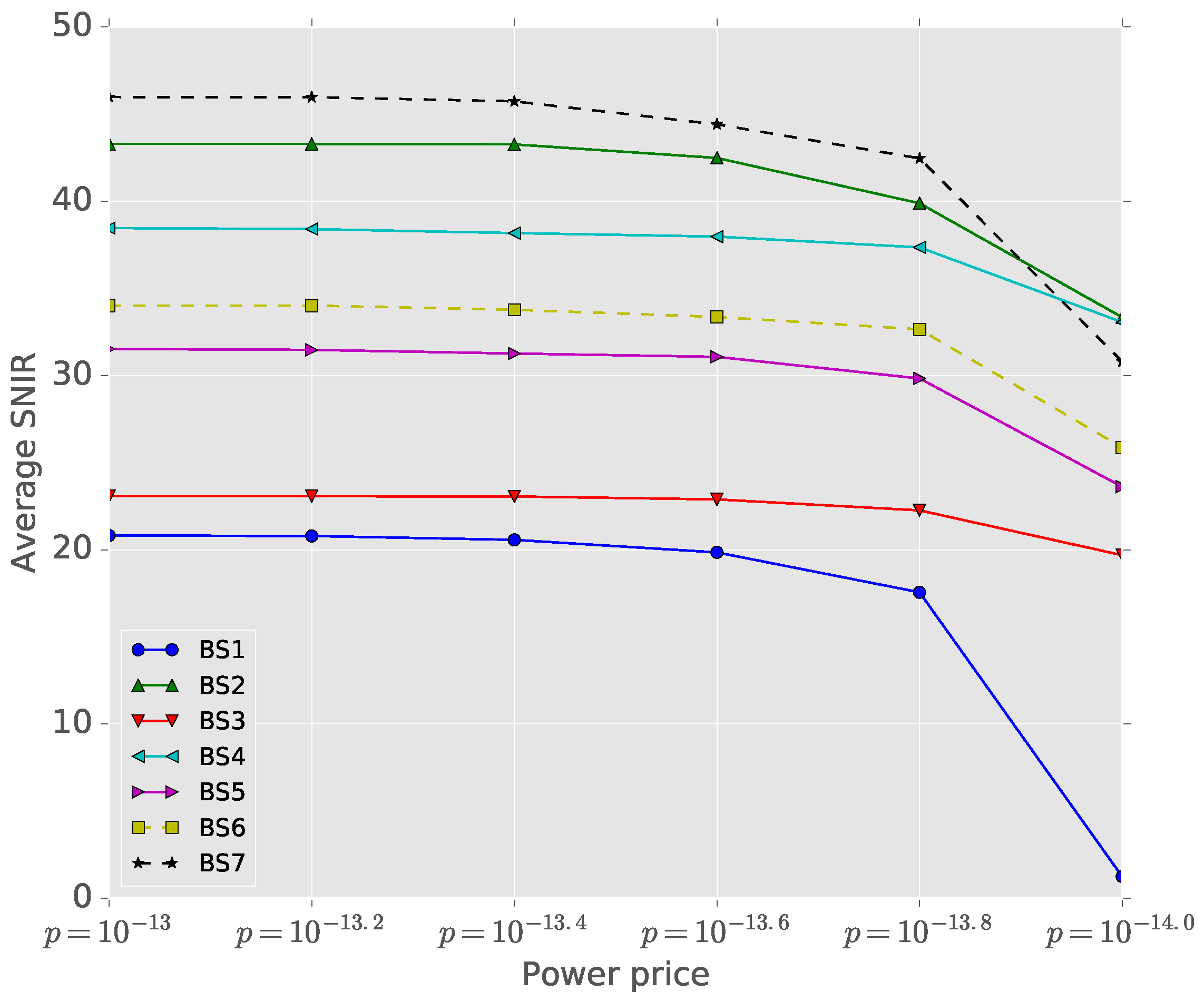
| BS1 | BS2 | BS3 | BS4 | BS5 | BS6 | BS7 | |
| 1.00 | 0.00 | 0.00 | 0.00 | 0.00 | 0.00 | 0.00 | |
| 1.00 | 0.00 | 0.00 | 0.00 | 0.00 | 0.00 | 0.00 | |
| 0.74 | 0.00 | 0.00 | 0.00 | 0.00 | 0.00 | 0.26 | |
| 0.81 | 0.00 | 0.00 | 0.00 | 0.19 | 0.00 | 0.00 | |
| 0.59 | 0.00 | 0.00 | 0.00 | 0.41 | 0.00 | 0.00 | |
| 0.00 | 0.00 | 0.00 | 0.00 | 0.00 | 0.00 | 1.00 | |
| 0.02 | 0.98 | 0.00 | 0.00 | 0.00 | 0.00 | 0.00 | |
| 0.00 | 0.00 | 0.00 | 0.00 | 0.00 | 0.72 | 0.28 | |
| 0.19 | 0.00 | 0.00 | 0.02 | 0.79 | 0.00 | 0.00 | |
| Average | 0.49 | 0.11 | 0.00 | 0.00 | 0.15 | 0.08 | 0.17 |
| 0.22 | 0.00 | 0.00 | 0.00 | 0.20 | 0.48 | 0.10 | |
| 0.14 | 0.29 | 0.57 | 0.00 | 0.00 | 0.00 | 0.00 | |
| 0.14 | 0.28 | 0.00 | 0.00 | 0.00 | 0.15 | 0.43 | |
| 0.24 | 0.00 | 0.00 | 0.53 | 0.23 | 0.00 | 0.00 | |
| 0.11 | 0.00 | 0.00 | 0.00 | 0.43 | 0.46 | 0.00 | |
| 0.25 | 0.00 | 0.00 | 0.00 | 0.00 | 0.26 | 0.49 | |
| 0.09 | 0.41 | 0.30 | 0.00 | 0.00 | 0.00 | 0.20 | |
| 0.00 | 0.00 | 0.00 | 0.00 | 0.00 | 0.11 | 0.89 | |
| 0.24 | 0.00 | 0.00 | 0.31 | 0.45 | 0.00 | 0.00 | |
| Average | 0.16 | 0.11 | 0.10 | 0.09 | 0.15 | 0.16 | 0.23 |
| BS1 | BS2 | BS3 | BS4 | BS5 | BS6 | BS7 | |
|---|---|---|---|---|---|---|---|
| 22.55 | 41.85 | 22.36 | 37.19 | 30.53 | 32.93 | 44.44 | |
| 22.55 | 42.35 | 22.45 | 37.25 | 30.54 | 32.94 | 44.54 | |
| 22.55 | 42.11 | 22.38 | 37.22 | 30.56 | 33.06 | 45.47 | |
| 22.55 | 41.92 | 22.40 | 37.92 | 32.67 | 33.21 | 44.54 | |
| 22.55 | 41.93 | 22.39 | 37.45 | 32.16 | 33.91 | 44.65 | |
| 22.55 | 43.13 | 22.41 | 37.26 | 30.59 | 33.22 | 50.43 | |
| 22.55 | 46.99 | 23.02 | 37.40 | 30.58 | 32.99 | 44.89 | |
| 22.55 | 42.20 | 22.40 | 37.31 | 30.79 | 37.66 | 49.23 | |
| 22.55 | 41.99 | 22.48 | 42.28 | 35.12 | 33.23 | 44.59 | |
| Average | 22.55 | 42.72 | 22.48 | 37.92 | 31.50 | 33.68 | 45.86 |
| BS1 | BS2 | BS3 | BS4 | BS5 | BS6 | BS7 | |
|---|---|---|---|---|---|---|---|
| 1.00 | 0.00 | 0.00 | 0.00 | 0.00 | 0.00 | 0.00 | |
| 1.00 | 0.00 | 0.00 | 0.00 | 0.00 | 0.00 | 0.00 | |
| 1.00 | 0.00 | 0.00 | 0.00 | 0.00 | 0.00 | 0.00 | |
| 1.00 | 0.00 | 0.00 | 0.00 | 0.00 | 0.00 | 0.00 | |
| 1.00 | 0.00 | 0.00 | 0.00 | 0.00 | 0.00 | 0.00 | |
| 0.97 | 0.00 | 0.00 | 0.00 | 0.00 | 0.00 | 0.03 | |
| 1.00 | 0.00 | 0.00 | 0.00 | 0.00 | 0.00 | 0.00 | |
| 0.74 | 0.00 | 0.00 | 0.00 | 0.00 | 0.26 | 0.00 | |
| 0.63 | 0.00 | 0.00 | 0.00 | 0.37 | 0.00 | 0.00 | |
| Average | 0.93 | 0.00 | 0.00 | 0.00 | 0.04 | 0.03 | 0.00 |
© 2016 by the authors; licensee MDPI, Basel, Switzerland. This article is an open access article distributed under the terms and conditions of the Creative Commons Attribution (CC-BY) license (http://creativecommons.org/licenses/by/4.0/).
Share and Cite
Lee, J.; Pak, D. A Game Theoretic Optimization Method for Energy Efficient Global Connectivity in Hybrid Wireless Sensor Networks. Sensors 2016, 16, 1380. https://doi.org/10.3390/s16091380
Lee J, Pak D. A Game Theoretic Optimization Method for Energy Efficient Global Connectivity in Hybrid Wireless Sensor Networks. Sensors. 2016; 16(9):1380. https://doi.org/10.3390/s16091380
Chicago/Turabian StyleLee, JongHyup, and Dohyun Pak. 2016. "A Game Theoretic Optimization Method for Energy Efficient Global Connectivity in Hybrid Wireless Sensor Networks" Sensors 16, no. 9: 1380. https://doi.org/10.3390/s16091380
APA StyleLee, J., & Pak, D. (2016). A Game Theoretic Optimization Method for Energy Efficient Global Connectivity in Hybrid Wireless Sensor Networks. Sensors, 16(9), 1380. https://doi.org/10.3390/s16091380





